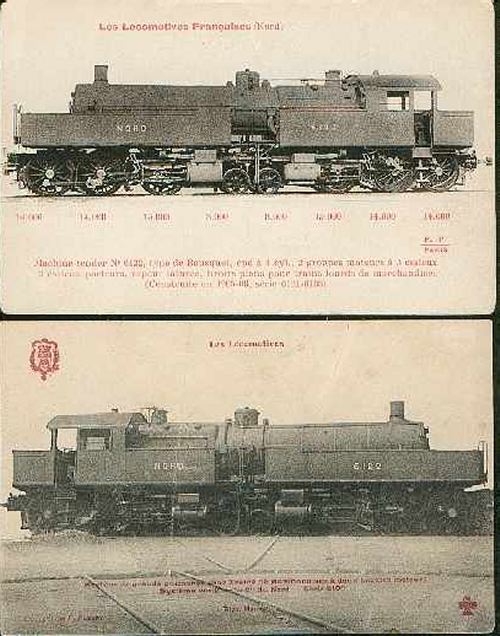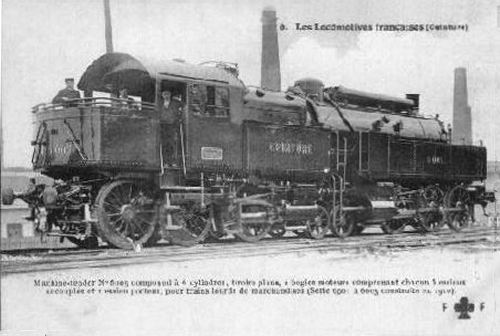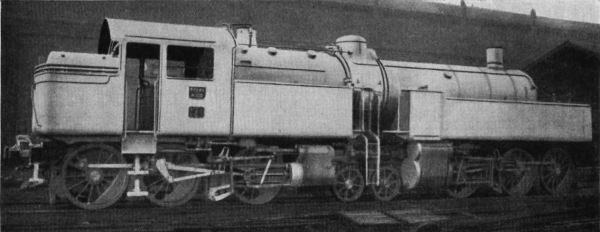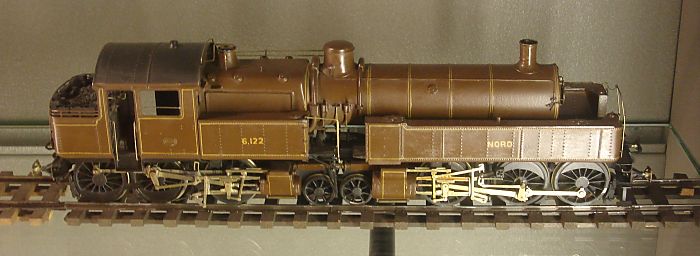
|
Above: A dimensioned drawing of a du Bousquet of the Nord.
|
The wheel arrangement was 031-130, with the large driving wheels leading; the small wheels, being in the centre of the locomotive, had no guiding function but simply supported the weight of the cylinders. The rear truck carried the high pressure cylinders and its bearing was a simple pivot moving in one plane, which reduced the high-pressure steam connection from the boiler to a simple rotating joint throgh the centre of the pivot. The front truck carried the low pressure cylinders, and received steam from the rear truck via pipes with swivelling and telescopic sections to permit relative movement. The front bearing was spherical to allow misalignment in tilt between front and rear trucks.
The boilers were fitted with 130 Serve tubes (these had corrugations to incease surface area and were named after their French inventor) and there was no superheating.
 |
| Left: Du Bousquet No 6122 of the Nord as pictured on contemporary postcards.
Note that the water tanks on the front truck extend well ahead of the boiler. Both front and rear tanks were mounted on the main chassis; the gap between them in the centre was to give access to the flexible steam pipes.
Image by kind permission of Roland Arzul, whose superb website on the French railway system can be found at: http://perso.wanadoo.fr/roland.arzul
|
Since the cylinders of the powered trucks were close together, it was relatively straightforward to pass the exhaust from the rear high-pressure wheel-axle unit to the low-pressure cylinders on the front unit, with a minimum of pipework;. The piping between the high and low pressure cylinders had universal and telescopic joints to allow movement. The low-pressure exhaust piping was made of cloth-reinforced rubber, which appears to have stood up to the job well.
The du Bousquets were painted chocolate brown like all the compound engines of the Nord network. The 48 engines were assigned to the dépots of Le Bourget and Hirson, and worked the heavy coal trains on the Hirson-Valenciennes and Le Bourget-Lens routes. However, in the end most of their work was done on the Ceinture (Belt or Girdle) lines around Paris.

THE STORY OF THE CEINTURES.
The Grande Ceinture was the ‘Outer Circle’ line of Paris, which opened in 1881-82, initially built and owned by the Nord, Est and PLM railways, but operated independently by the Syndicate de Ceintures and having its own locomotives, including the unique du Bousquet 031+130 tanks. The main purpose of the line was to move freight around Paris, but it also ran suburban passenger services. There were also two sections making up the Petite Ceinture or "inner circle" dating from 1851.
The Ceinture services required tank locomotives able to travel in both directions with equal ease, and having enough tractive effort to draw heavy goods trains on an often difficult route profile, and the Du Bousquets met these needs effectively.
Du Bousquet was a leading locomotive designer and designed several famous compound locomotives of conventional construction, including the noted Baltic "ten-wheeler".
In 1921, 34 of these machines were transferred from the Nord to the Syndicate de Ceintures, and assigned to the dépot of Bobigny. When the Syndicate de Ceintures was dissolved in 1935, due to the decline of both goods and passenger traffic, the machines were transferred back to the Nord network. In 1938, they were renumbered as 2-031+130 1 to 47, machine No 6155 having been destroyed during the First World War. These machines were little by little replaced on the Nord by the 151TQ type, the last Du Bousquet not being taken out of service until 1952.

DU BOUSQUETS OF THE EST.
In addition to the 48 units (Nos 6121 to 6168) owned by the Nord, the Est railway acquired 13 Bousquets between 1910 and 1911 (Nos 6101 to 6113). They were identical to those of the Nord, being built to the same drawings. They were reassigned to the Syndicate de Ceintures in 1921 then went to the Nord in 1936. They too were renumbered, as 2-031+130 TB 1 to 12 in 1938, and also persisted until the early Fifties.
 |
| Left: No. 6107, one of the du Bousquets of the Est.
This locomotive was built in 1910-11, and transferred to the Ceinture in 1921.
Note that this version has a cylindrical tank on top of the boiler that is not present on the Nord locomotives. It was presumably either a feedwater heater or a brake reservoir- which is currently unknown.
Image courtesy of Bruno Bretelle.
|

DU BOUSQUETS OF THE CEINTURES.
The Syndicate de Ceintures itself had 38 similar locomotives constructed between 1909 and 1913 (Nos 6001 to 6038). Of these, 32 were built by the Societe des Batignolles, and 6 by the Cockerill works in Seraing. These were more powerful versions; some had their performance improved further around 1930 when they were given superheating. During the gradual decline of the Syndicate, these machines went to the State network. They were not used after 1949.
 |
| Left: No. 6005, one of the du Bousquets built directly for the Syndicate de Ceintures.
If you are puzzled by the legend on the postcard, bear in mind that in Europe a "machine-tender" is a tank engine, and NOT a tender locomotive. Strange but true.
Once again there is a cylindrical tank on top of the boiler .
Image courtesy of Bruno Bretelle.
|
 |
| Left: du Bousquet No 6005 from another angle.
The word "ceinture" can just be made out on the rear water tank, and a lot of computer enhancement reveals that this is No 6005 again.
Image by kind permission of Roland Arzul.
|
In summary, the Nord railway ordered 48 Bousquets, 38 were ordered by the Syndicate de Ceintures and 13 by the Est railway. 84 units out of the 99 were transferred to the Grande Ceinture.

SOME VITAL STATISTICS (Nord, Est & Ceinture versions only)
Cylinder diam HP400 mm
Cylinder diam LP630 mm
Boiler pressure16 kg/cm2 (228 psi)
Boiler tubes, number130
Boiler tubes, diam70 mm
Boiler tubes, length4.75 m
Heating surface, firebox12 m2
Heating surface, tubes233 m2
Driving wheel diam1.46 m
Truck wheel, diam850 mm
Water capacity12.8 m3
Coal capacity5 tonne
Weight, empty78 tonne
Weight, service102 tonne
Weight, adhesive72-90 tonne
| | | | | | | | | | | | | | | | | | | | | | | | | | | | | |
Data from Meyer
According to Meyer, the Bousquets were rendered obsolete by the increase in power of rigid locomotives.

DU BOUSQUETS OUTSIDE FRANCE.
In spite of their great success in their home country, the du Bousquets saw only limited use elsewhere. A batch (number unknown) were built for the Pekin-Hankow railway in China; these were the same as the French du Bousquets except in minor details. One wonders what the local drivers made of them.
 |
| Left: One of the du Bousquets built for the Pekin-Hankow railway.
They were built to the 1.435m standard gauge, and differed only in details from the Bousquets in French service.
This appears to be a manufacturer's photo. The Pekin locomotives were built by Haine-Saint-Pierre
Image from Meyer
|
Another batch was built for the Andalusian Railways in Spain, modified to work on the 5' 6'' broad gauge. Their history was unknown, to me at any rate, until Santiago Gonzlez Estrada kindly provided the following information:
Locomotives 601-619 were bought by Andalusian Railways from Usines Metallurgiques de Hainaulten in 1912. When transferred to RENFE (National Network of the Spanish Railroads) only four were operated; they formed the group of numbers 062-0401-0404. They suffered much wear on the steeply graded line from Cordova to Belmez (with inclines of 30/33) and were scrapped in 1946/47. Water capacity in the side tanks was inadequate, and was supplemented by a wooden water tank carried on a small wagon. The tank was constructed of wood to minimise weight.

BIBLIOGRAPHY
"10 Décennies de Locomotives à Vapeur sur le Réseau du Nord"
by Lucien-Maurice Vilain, published in France in the 70's and now out of print.
"Articulated Locomotives" by Lionel Wiener. A classic on the subject.






















